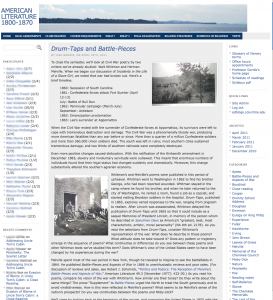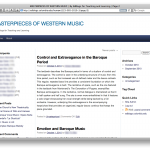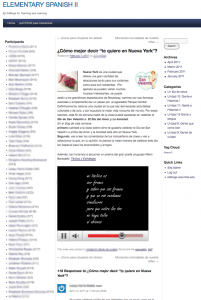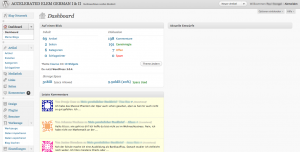- Creating a Community of Readers
- Understanding How a Public Audience Affects Writing
- Fostering a Sense of Ownership Among Students
- Establishing Continuity Across Class Sessions
- Using a Public, Localized Language Blog
Creating a Community of Readers
 Professor Lisa Gordis (English, Barnard College) uses EdBlogs to teach an American Literature Survey class that often enrolls more than thirty students. Professor Gordis has been using Edblogs sites for several semesters, after using wikis in previous years to organize assignments that required the flexibility of a wiki. Trading flexibility for simplicity, Professor Gordis continues to use the EdBlog system and makes extensive use of the multi-author model. With EdBlogs, there are many features (such as the “Participants widget”) that help to simplify the evaluation of student work.
Professor Lisa Gordis (English, Barnard College) uses EdBlogs to teach an American Literature Survey class that often enrolls more than thirty students. Professor Gordis has been using Edblogs sites for several semesters, after using wikis in previous years to organize assignments that required the flexibility of a wiki. Trading flexibility for simplicity, Professor Gordis continues to use the EdBlog system and makes extensive use of the multi-author model. With EdBlogs, there are many features (such as the “Participants widget”) that help to simplify the evaluation of student work.
Professor Gordis uses categories, the Participant widget, and the unique-to-Edblogs structure of “posts” and “pages” to create a class portfolio of students’ responses to texts. She structures the blog to direct student focus for each new text, reminding students to read for overarching course motifs and to share links and scans of supplementary materials, all of which enrich responses. New categories are introduced with each reading and students who compose a related post use appropriate categories to organize related posts on the site. Professor Gordis uses the “sticky” feature to keep her post at the top of each category for students to see. All new posts by students feed below that post, the most recent on top just below Professor Gordis’. Pages house the course syllabus, reading strategies, assignments, and other static logistical items.
By the end of the semester, Professor Gordis can easily review all student work by simply clicking each student’s name as listed by the Participants widget. Entries on the course blog may also be arranged by major course theme or motifs (categories), providing students a powerful review tool for course exams and papers.
Understanding How a Public Audience Affects Writing
 Alondra Nelson uses an EdBlogs site for her Sociology course called “The Social Life of DNA”. She encourages “students to use the blog to experiment with a different type of scholarly prose from what they might use to write a paper.”
Alondra Nelson uses an EdBlogs site for her Sociology course called “The Social Life of DNA”. She encourages “students to use the blog to experiment with a different type of scholarly prose from what they might use to write a paper.”
Professor Nelson uses the blog to replace short weekly papers that students would normally submit to the full class for review. Students alternate between being posters (e.g. posting their short papers) and being commenters. When students post, they keep their thoughts in order via categories and tags.
But most importantly, the blog is teaching students to write for a ‘public’ audience. The site has approximately 150 subscribers in the public sphere who come from organizations that are affiliated with course. When writing for this audience, professor Nelson notes that students are gaining a valuable skill: “the blog is pedagogically helpful for graduate students because it forces them to learn to convey and distill complex ideas and arguments into 750 words (or less). This skill is useful for them when they are doing both written and oral qualifying exams.”
See Dan Beeby describe this blog at CCNMTL’s NME 2010 (52:04-55:15)
Fostering a Sense of Ownership Among Students
 Maja Cerar teaches Music Humanities and uses Edblogs as her course Web site. She notes that “Courseworks’ Discussion Board [was] cumbersome to navigate and track” and that EdBlogs “gives students a greater sense of ownership of the course, to very positive effects.”
Maja Cerar teaches Music Humanities and uses Edblogs as her course Web site. She notes that “Courseworks’ Discussion Board [was] cumbersome to navigate and track” and that EdBlogs “gives students a greater sense of ownership of the course, to very positive effects.”
In Professor Cerar’s class, the students can choose (within some limits) the weeks in which they want to post. This flexible schedule of writing assignments allows students to focus on subjects that interest them most. Students are required to post more than 24 hours prior to the class session and all students are required to read all posts.
These two elements (choice of posts and required reading) will lead to a greater connection with the materials (since students choose topics that catch their interest) and they will have greater familiarity with their peers’ thoughts (via the reading requirement).
This quote from Maja sums up her course experience in EdBlogs nicely, “Students seemed to have an increased need to communicate how they found their own ways of wrapping their minds around the somewhat less immediately approachable repertoire by finding analogies in other arts disciplines. What more can an instructor wish for than students actively pursuing their individual anchoring of certain knowledge? They’ve invested an explorer’s energy into it! It was satisfying to see that certain conversations lingered on the blog beyond assignments and tests.”
Excerpt from CCNMTL’s 2010 NME describing this course blog (watch 21:09-27:45)
Establishing Continuity Across Class Sessions
 Professor Juan Jimenez (Latin American/Iberian Culture) and Professor Maria Lozano (Spanish & Latin American Cultures, Barnard College) use EdBlogs to facilitate a course forum of over 50 student participants from multiple sections of Elementary Spanish. The blog allows students to comment on topics created by Professor Jimenez or Professor Lozano as well as reply to peers in the target language.
Professor Juan Jimenez (Latin American/Iberian Culture) and Professor Maria Lozano (Spanish & Latin American Cultures, Barnard College) use EdBlogs to facilitate a course forum of over 50 student participants from multiple sections of Elementary Spanish. The blog allows students to comment on topics created by Professor Jimenez or Professor Lozano as well as reply to peers in the target language.
On a monthly basis Professors Jimenez or Lozano post a discussion topic for students to comment on in Spanish. These discussions continue over many months and in some cases posts garner as many as 120 comments.
Happily EdBlogs has features that make managing comments a snap. EdBlogs provides the “Participants widget”, a feature that quickly displays the number of comments that each student has made and allows the instructors to drill down and view specific comments related to a post. EdBlogs also offers robust administration features for moderating comments. Additionally, most EdBlog themes accommodate nested comments, making it easier to read threaded replies below a post.
The multi-section blog provides a space for students to meet and work with their peers in ways that are otherwise impossible due to scheduling conflicts and space restrictions. Students become exposed to multiple perspectives and the blog becomes a fun place to practice language in a social environment.
Using a Public, Localized Language Blog
 Jutta Schmiers-Heller (Germanic Languages) has created multiple blogs in which her students can practice the language with each other. Jutta writes, “most of the blog work is extra and outside of the classroom. I might substitute a blog assignment for an essay on occasion.”
Jutta Schmiers-Heller (Germanic Languages) has created multiple blogs in which her students can practice the language with each other. Jutta writes, “most of the blog work is extra and outside of the classroom. I might substitute a blog assignment for an essay on occasion.”
Recently for her accelerated Elementary German Jutta took advantage of EdBlog’s localization feature and set most of the Blog interface to German to give students a more immersive experience. Professor Schmiers-Heller sees a benefit to starting with the blog interface in English and switching it to German depending on the ability of the class.
Jutta has tweaked the privacy settings of her blog to make it viewable (for reading and for commenting) by anyone that has the web address. This allows Professor Schmiers-Heller and her students to discuss topics in German with student pen pals from a school in Germany. Jutta comments on the experience as a “…worthwhile and challenging experience for both sides as they realize the big cultural gap between the two groups.” By providing a safe public forum for discussion in German, EdBlogs’ public setting brings a worldly dynamic to language study at Columbia.
Commenting on the overall experience, Professor Schmiers-Heller reflects, “mostly students have been positive about the use of blogs. They found the technology fairly easy to use and have enjoyed the exchanges with others.”
